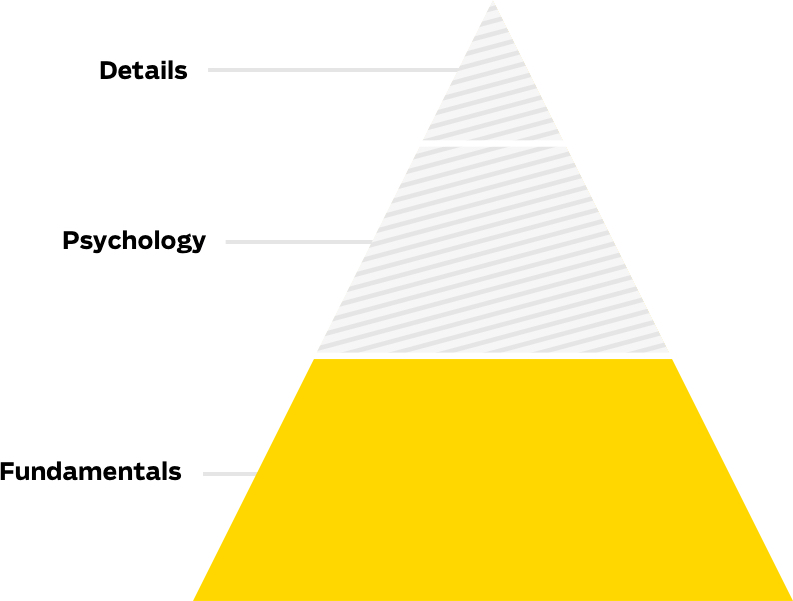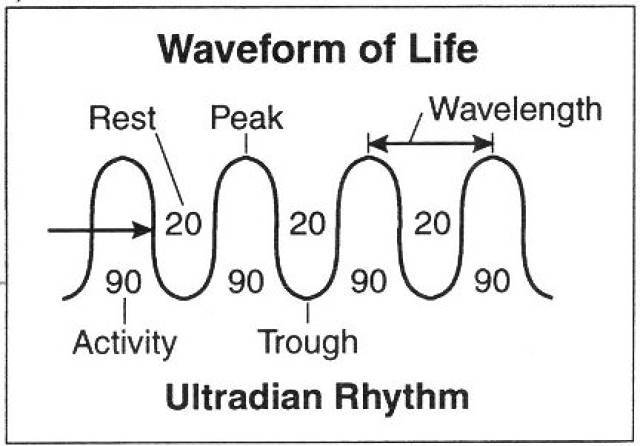If you’re a regular reader of Lifehack, you’ll know that we have plenty of articles that feature these apps and tech tricks. All these techniques are useful, but if you’re not careful, you may forget one of the basics of productivity – your personal energy levels. On this point, I want to introduce to you the 3 Tiers of Productivity.[1] These can be explained as a pyramid, with the base (and biggest part) made up of fundamentals, the middle part of psychology, and the apex (and also the smallest part) consisting of details.
The fundamentals part is the least sexy, and therefore, typically attracts the least interest. However, it’s actually the most important part. Fundamentals refers to adequate sleep, a healthy diet, a clean environment, and knowing exactly what you’re going to do. In other words – how you manage your personal energy. If you’re not as productive as you’d like to be, then you may be lacking personal energy.
Why Your Energy Levels Are Low, and Why This Matters
If you’re like most people, you probably respond to rising demands in the workplace by putting in longer hours. However, this takes a toll on your physical, emotional and mental health. This inevitably leads to declining levels of engagement, increasing levels of distraction – and a significant dip in your productivity. As I mentioned in the introduction, once our productivity takes a hit, we gravitate towards “magical” tools and tricks to help us keep on track. But there’s a problem with this. Namely, that most of these tools and tricks focus almost exclusively on psychology and details. They fail to address the fundamentals, thus leaving us with an artificial, and oftentimes unsustainable boost in productivity. If you want to be a productivity superstar, then you need to get the fundamentals right. Luckily, there is a little-known method that can help you out with this.
How Natural Cycles Help You Perform Better
Most people aren’t aware that their personal energy is determined by natural cycles known as ultradian rhythms. These are recurrent periods or cycles that are repeated throughout a 24-hour day. When you work with instead of against the ultradian rhythms, you will perform better. When your energy levels are high, you can concentrate on the tasks at hand; when your energy levels hit rock bottom, this is the best time to rest. Psychophysiologist Peretz Lavie conducted a series of experiments that revealed the following:
These daily cycles reveal when we’re most likely to feel at our best – and when we’re most likely to feel too groggy to continue.
Align with Your Natural Cycles and Boost Your Performance
You must get the fundamentals of personal energy right if you’re to reach the heights of the super-productive. It all starts with getting adequate and regular sleep (at least eight hours per night). Good sleep allows you to rest and rejuvenate. It gives you the energy to get on with doing what you want to do. In turn, this leads to a significant boost in your performance. You’ll also find yourself easily surpassing the energy and productivity levels of people who don’t sleep well. A Federal Aviation Administration study of pilots on long haul flights shows the vital importance of resting when your energy levels are low:[2] You may not be aware of this, but sleep can also help you solve problems. For instance, it’s not uncommon to wake up with the answer to a problem that you’d earlier been unable to resolve. Find out more about this in another article Why Sleeping on a Difficult Problem Helps You Get the Answer Clearly, if you can learn to follow your natural daily cycles, you’ll be able to do your best work when you have the most energy, and you’ll also know the most suitable time to take naps, rest and sleep.
How to Take Care of Your Energy
Want to get started with boosting your energy and productivity levels? Here’s my recommendations.
Identify your energy cycle
The first key thing to do, is to calculate your biological prime times. You can do this by: By doing the above, you’ll be able to determine your peak activity times – and your best times to rest and sleep.[3]
Schedule activities according to your energy levels
It’s critical that you know the effort and energy needed to complete upcoming tasks. Having this information will allow you to set the priority and importance of the tasks. You can then easily schedule the important tasks (or tasks that require a high level of concentration) at times when your personal energy is at or near its peak. Examples of these tasks include creative work like writing, or problem solving work such as learning to file your tax returns. And of course the opposite is true. Tasks that need less thought-power or energy should be scheduled to take place during your low-energy periods.
Break your work sessions into 90-minute blocks and take 15-minute breaks every 90 minutes
When you break your work into 90-minute blocks, you’ll immediately experience a boost in your productivity. This is because 90 minutes is the ideal working duration before your mind and body needs to take a break. And how long should your break be? Well, it appears that 15-minute breaks are the ideal complement to the 90-minute sessions. By following the above routine, you’ll notice that you’ll have enhanced motivation to work because 90 minutes seems a manageable amount of time to work, especially when a 15-minute break is on the horizon. While the 15-minute break can be used to simply go for a walk, or make yourself a drink, you may want to consider taking a nap. Napping for just 15-20 minutes enables you to recharge your personal energy. (Be careful with longer naps, as these can disrupt your sleep cycle.) Read more about napping at work in another article A 20-Minute Nap at Work Makes You Awake and Productive the Whole Day As you can see from the tips in this article, to manage your productivity levels, you need to get the foundations right first. This means getting enough sleep, eating a healthy diet, ensuring your environment is clean and orderly, and most importantly, learning how to align your work with your natural cycles. Featured photo credit: Picjumbo via picjumbo.com

